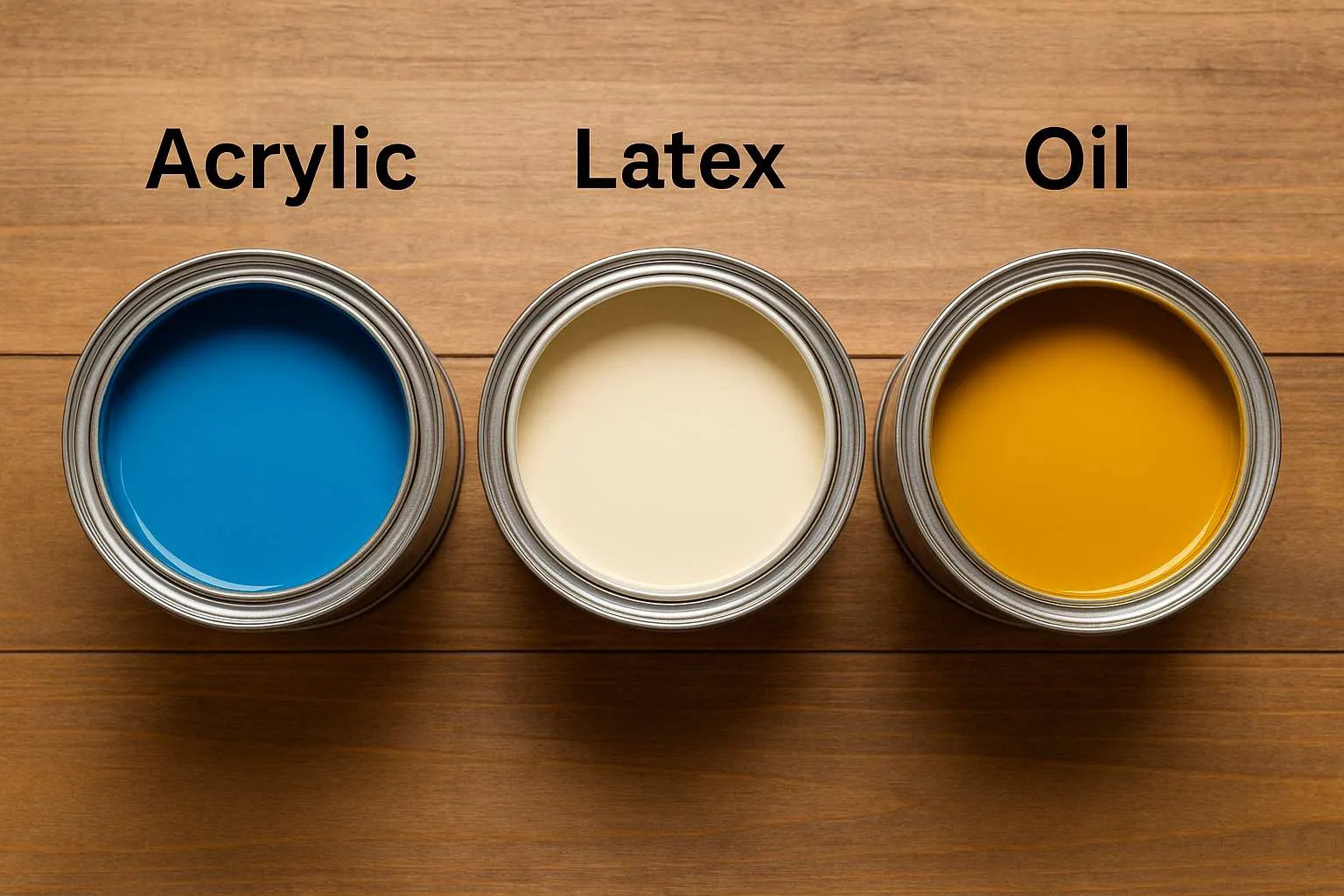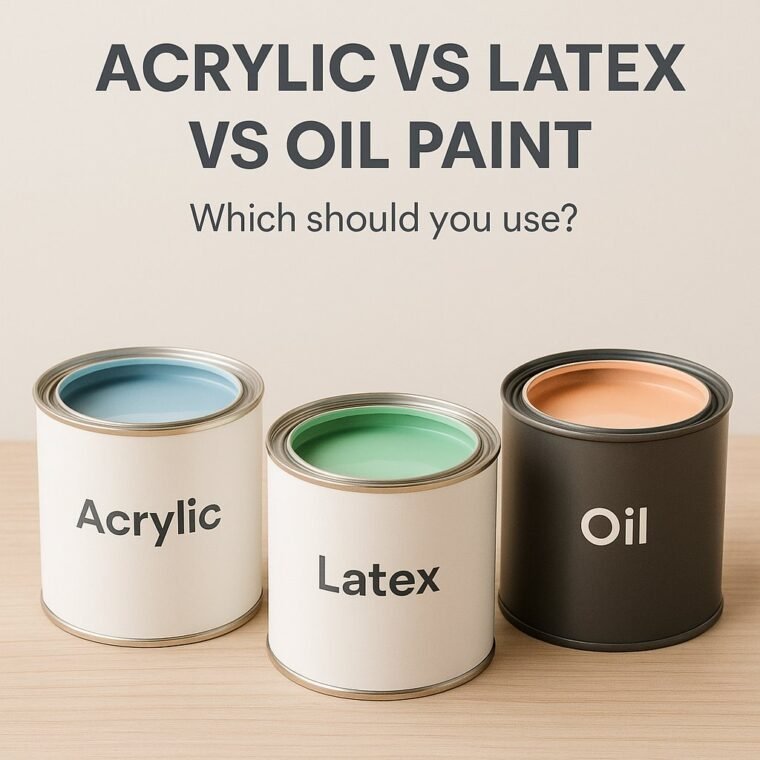Acrylic vs Latex vs Oil Paint
When it comes to painting your home, choosing the right type of paint can make all the difference in durability, appearance, and ease of maintenance. You’ve probably heard of acrylic, latex, and oil-based paints—but what’s the real difference? And how do you know which one to use where?
In this guide, our expert Vancouver painters break down the key features of each paint type, explore the best paint for interior walls, and help you confidently choose the right finish for every room or surface in your home.
Understanding the Basics: Types of paint at a Glance
Before diving into comparisons, let’s define each Types of paint:
Acrylic Paint
A water-based paint made with acrylic resin. Known for its flexibility and strong adhesion, acrylic paint is commonly used on surfaces like wood, masonry, and drywall.
Latex Paint
Also water-based, latex paint is often confused with acrylic—but there’s a subtle difference. Latex paint contains vinyl resins, making it slightly less elastic than acrylic. It’s ideal for most general interior walls.
Oil-Based Paint
A traditional choice, oil paint is made with a solvent base (usually mineral spirits). It dries slowly but forms a very hard, durable surface—perfect for trim and high-contact areas.
Acrylic vs. Latex vs. Oil Paint: The Key Differences

Let’s look at a detailed paint types comparison to help you spot what sets each one apart.
| Feature | Acrylic | Latex | Oil-Based |
|---|---|---|---|
| Base | Water | Water | Oil (solvent) |
| Drying Time | Fast | Fast | Slow |
| Durability | High | Moderate | Very High |
| Clean-Up | Soap & water | Soap & water | Paint thinner |
| Best For | Exterior walls, cabinets, furniture | Interior walls & ceilings | Trim, doors, cabinets |
If you’re planning to refresh a room, our team has handled many interior painting projects where we’ve seen firsthand how the wrong paint type can cause bubbling, peeling, or early fading.
Choosing the Right Paint for Interior Walls
One of the most common questions we hear is: What’s the best paint for interior walls?
For most rooms like bedrooms, living rooms, and hallways, latex paint is the top choice. It’s affordable, easy to apply, dries quickly, and emits low odour. However, if you’re dealing with a high-humidity area like a bathroom or kitchen, acrylic paint may offer better moisture resistance.
For homeowners in urban settings such as condos or offices, acrylic paints can also be a better fit. We’ve applied this in several condo painting projects where durability was crucial but fumes needed to stay low.
When to Choose Oil-Based Paint
Oil paint still has its place, especially in areas that demand high durability or a glassy smooth finish. Think:
-
Baseboards and trim
-
Doors
-
Cabinetry
While oil-based paints are harder to clean up (you’ll need mineral spirits) and release more fumes, their long-lasting finish is ideal for house painting jobs where elegance and wear resistance are non-negotiable.
Acrylic vs. Latex Paint: What’s the Difference?
It’s easy to confuse these two because they’re both water-based. So let’s clarify the difference between acrylic and latex paint:
-
Acrylic contains more acrylic resins, making it more elastic and suitable for outdoor applications, or materials that expand and contract (like wood).
-
Latex is slightly less durable but more budget-friendly and perfect for interior walls that don’t see too much moisture or impact.
We’ve used both in exterior painting services depending on the structure type, wood condition, and climate exposure.
Safe Way to Change Paint on Ceilings or Popcorn Surfaces
Switching ceiling paint, especially with popcorn texture, requires care. If you’re considering updating an older ceiling:
-
Use a latex-based ceiling paint for standard drywall.
-
For textured ceilings, opt for acrylic to prevent flaking.
-
Never use oil-based paint on popcorn ceilings—it can cause sagging.
Need help? Check out our popcorn ceiling removal service to see what’s involved and how professionals handle it safely.
What About Outdoor Spaces Like Decks?
For outdoor projects like decks and fences, your best bet is acrylic paint or dedicated stains. Acrylic sticks better to wood exposed to the elements, and it’s flexible enough to resist cracking. For wood tones, staining is usually preferred.
We’ve worked on numerous deck painting and deck staining jobs across Metro Vancouver and can help you choose the right material for lasting curb appeal.
Common Mistakes to Avoid
Here are some pitfalls you can easily sidestep:
-
Skipping primer when switching between paint types (especially oil to water-based)
-
Using the wrong finish—e.g. matte paint in a bathroom
-
Not considering surface movement—wood expands, so choose acrylic or flexible latex
Our past painting projects are filled with real-life transformations where the right material choice made all the difference.
Final Thoughts: Choose with Confidence
Choosing between acrylic, latex, and oil paint isn’t just about what’s available on the shelf—it’s about understanding your space, your needs, and how much wear and tear the surface will face.
If you’re not sure where to start, our expert team at Brush and Beyond Painting is here to help. Whether you’re considering a full home makeover or just a room refresh, we offer trusted painting services in North Vancouver and reliable painting services in Burnaby tailored to your space and style. Feel free to contact us here for professional advice or a personalized quote.
